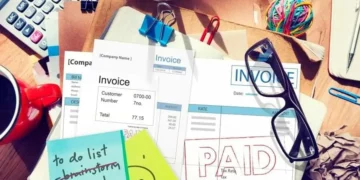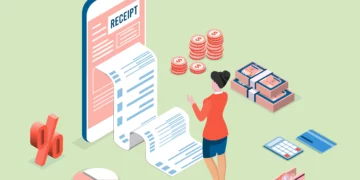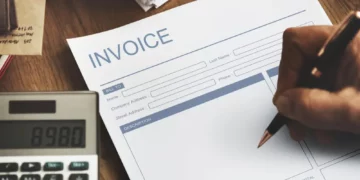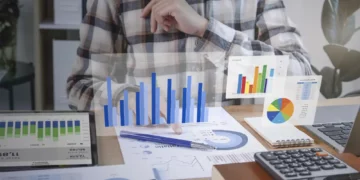Last Updated on November 28, 2025
Introduction
In business, there are a lot of different types of documents that you will create and use. Two of the most common are purchase orders and invoices. While they may seem similar, there are some critical differences between them. Purchasing and accounting professionals often use the terms “purchase order” and “invoice” interchangeably, but there is a distinction between the two documents.
A purchase order is a request from a buyer to a seller to supply specific goods or services. An invoice, on the other hand, is a document that records what was ordered and how much it cost. The sales invoice is sent to the buyer as proof of purchase. In this blog post, we’ll explore the differences between purchase orders and invoices in more detail.
What is a Purchase Order?
In a purchase order, the terms of the purchase are outlined between a buyer and a seller. The process usually begins when a buyer sends a purchase order to a seller, specifying the types and quantities of goods or services they wish to purchase.
Purchase requisitions and purchase orders may sound similar, but they’re actually quite different. A requisition is an internal company document, while a purchase order is a formal offer to buy goods or services.
In the purchase order, the procurement process is started when a buyer creates or submits a purchase order to a seller. The seller then reviews the purchase order and either accepts or rejects it. If the purchase order is accepted, the seller typically ships the goods or provides the services to the buyer within a specified time frame. Once the goods or services have been received, the buyer pays for them according to the payment terms outlined in the purchase order.
The contract purchase order is sometimes used for larger purchases that require more complex payment terms. In these cases, the purchase order serves as a contract between the buyer and seller, specifying the terms of the purchase and outlining the rights and obligations of both parties.
A blanket purchase order is a type of purchase order that authorizes a buyer to purchase, over a period of time, specified goods or services up to a stated maximum dollar amount.
Whether you’re a buyer or a seller, it’s essential to understand purchase orders and the purchase order process. This will help you ensure that all your transactions are smooth and efficient.
Quick Read: 10 Best Purchase Order Software
What Does a Purchase Order Contain?
A purchase order is a document created when a company wants to buy goods or services from another company. The sample purchase order form contains what is being believed, the quantity, the price, the terms of payment, and the delivery date.
It also usually has a reference number so both parties can keep track of the order. Purchase orders are generally created by the company’s purchasing department and then sent to the supplier. The supplier then either accepts or rejects the purchase order.
If the purchase order is accepted, the supplier will send an invoice to the company for the goods or services. The company will then pay the invoice according to the terms of payment that were agreed upon in the purchase order. The purchase order date is crucial as it commits the buyer to the supplier and the price. The purpose of purchase orders is to ensure that both parties are aware of what and how much is being bought during the purchasing process.
Purchase Order Procedure
- Review the purchase order and order details to ensure that the items are correct and there are no discrepancies.
- Verify that the purchase order is complete, including all required information and signatures.
- If everything is in order, sign and date the purchase order.
- Send the purchase order to the supplier for processing.
The purchase order should include the following information:
- Company name and address
- Contact person and phone number
- Order date
- PO number
- Billing address
- Shipping address
- Method of shipping (air, ground, etc.)
- Terms of payment
- List of items ordered, including quantities and unit prices
- Subtotal
- Shipping and handling charges
- Taxes (if applicable)
- Total amount due
In response to receiving the purchase order, the supplier will begin processing the order and will provide you with an invoice once the order has been shipped. The invoice will include the purchase order number for reference and the particulars of the purchase.
Upon receipt of the invoice, please review it carefully to ensure that everything listed on the purchase order was shipped and that the prices are correct. If there are any discrepancies, contact the supplier immediately to resolve them. Once everything is in order, remit payment according to the terms specified on the purchase order.
Benefits of Purchase Orders
- A purchase order can help streamline the ordering process for your business.
- By having a purchase order in place, you can keep better track of your spending and budget more effectively.
- Purchase orders can also help ensure that you receive the correct products or services from your suppliers and help avoid any potential misunderstandings.
- In some cases, using a purchase order may also help to secure better pricing from your supplier.
- Overall, a purchase order can provide numerous benefits for buyers and sellers involved in business transactions.
If you’re looking to streamline your business’s ordering process and save time and money, then consider using purchase orders. Purchase orders can help you keep track of spending and budget more effectively and avoid misunderstandings with suppliers. In some cases, they may also secure better pricing from your supplier. Ultimately, purchase orders can benefit buyers and sellers involved in business transactions. To negotiate discounted pricing or extra time to pay, your supplier may require a commitment from you in the form of a purchase order.
Purchase Order vs Sales Order
Purchase Order |
Sales Order | |
Order To Cash | The term purchase order refers to a contract between a buyer and a seller in which the buyer agrees to purchase goods or services from the seller at specified prices and quantities. | A sales order is an internal document created by a company to document a customer’s request for goods or services. |
Inventory Management | Purchase order requests a vendor to supply goods or services. | A sales order is a request from a customer for goods or services. |
Forecasting | Purchase orders can forecast demand because they represent a binding agreement between a buyer and seller. | Sales orders can also be used to forecast demand, but they are not binding. |
Pricing | The vendor sets the price of a purchase order. | The company sets the price of a sales order. |
What is an Invoice?
An invoice is a commercial document that itemizes and records a customer’s purchase of goods or services from a seller. An invoice serves as evidence of the sale and can be used by the buyer to request payment from the seller. Invoices are typically generated by businesses when products or services have been sold to customers.
The invoice will include important information such as the date of purchase, product details, quantity, and the total amount due. This buyer can use this information. The buyer can use this information to reconcile their records and ensure they are charged correctly. If you’re unsure about an invoice you’ve received, don’t hesitate to ask the seller for clarification. After all, it is in their best interest to ensure you’re happy with your purchase!
Purchase Order vs Invoice
Purchase Order |
Invoice |
| A purchase order (PO) is a document that confirms your intent to buy products or services from a supplier. | When goods or services are provided, an invoice is used to request payment. |
| A PO is created before services are rendered. | An invoice is created after services have been provided. |
| A PO may be generated manually or through an electronic system. | An invoice must always be generated electronically. |
| POs typically contain more detailed information about the products or services being purchased. | An invoice will generally contain less detail and will focus on the price of the goods or services provided. |
| Purchase order prevents overstocking of inventory. | An invoice prevents double billing. |
How do Businesses Manage Purchase Orders?
Many companies use purchase order management software for inventory management. This software helps keep track of inventory, budget, and supplier information. It can also help automate the ordering process. By using purchase order management software, businesses can save time and money.
Some companies choose to manage their purchase orders manually. This can be done by using a spreadsheet or by using paper forms. While this method can be time-consuming, having Allan also be helpful.
Whatever you choose can also be beneficial; keeping track of your purchase orders is essential. This will help you stay organized and ensure you get the products you need.
Automate Purchase Orders With Software
As a purchasing manager for your company, you’re spending a lot of time processing the purchase order system. But what if there were a way to automate purchase orders and make your job much more accessible? Luckily, there is!
Using software to automate purchase orders can save you time and hassle. Here’s how it works:
First, you’ll need to set up the software. This can be done easily and quickly and doesn’t require special skills or knowledge. Once the software is set up, you’ll need to enter basic information about the products or services you want to purchase.
Then, the software will generate a purchase requisition form automatically. You can then review the purchase order and make any necessary changes.
Finally, you’ll submit the purchase order and send the supplier. That’s it! Using software to automate purchase orders can save you a lot of time and hassle. So why not give it a try? The process will surprise you with its ease and effectiveness.










Discussion about this post